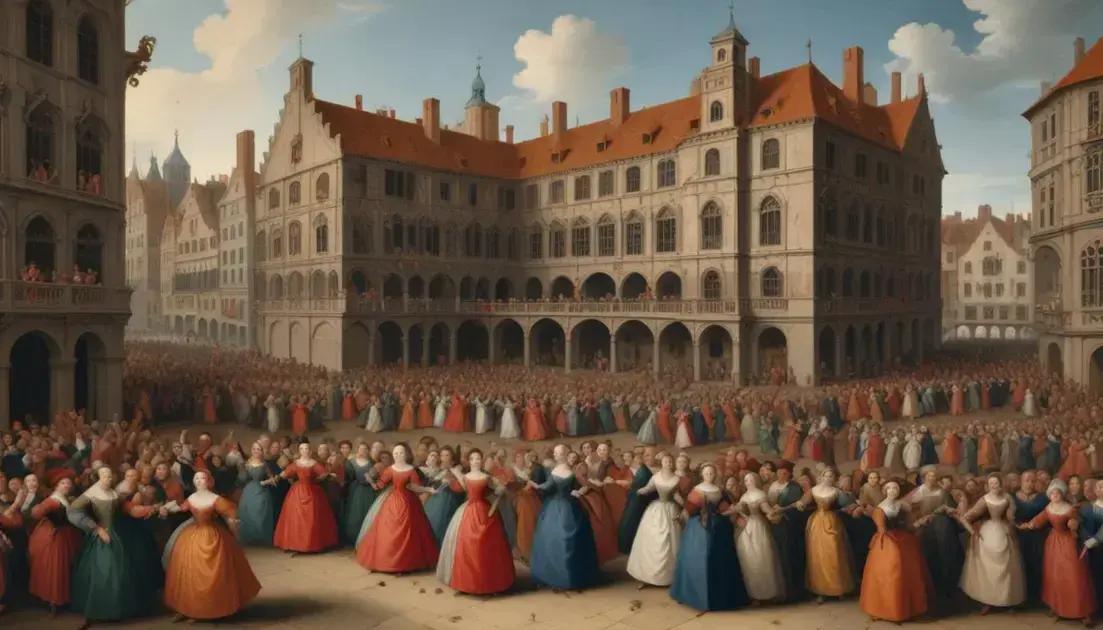
The Dancing Epidemic of 1518: When a City Danced to Exhaustion
The Dancing Epidemic of 1518 in Strasbourg was a mysterious event where hundreds of people danced uncontrollably for weeks. This phenomenon raised various theories, including mass hysteria and potential ergot poisoning. The outbreak demonstrated how emotional stress affected community behavior, highlighting the challenges of mental health awareness in that era. Its impact extended beyond Strasbourg, prompting discussions about human psychology and collective experiences that resonate even today.
Have you ever heard of the Dancing Epidemic of 1518? In a quaint city, a bizarre event unfolded, capturing the imagination and bewilderment of many. Join us as we explore this strange chapter in history!
Introduction to the Dancing Epidemic
The Dancing Epidemic started in July 1518 in Strasbourg, a city that was part of the Holy Roman Empire. It began when a woman danced fervently in the streets. At first, it seemed like a strange spectacle. But soon, others joined her. In a matter of days, dozens were dancing.
As time went on, the number of dancers grew. What was once a single person dancing turned into a crowd of hundreds. People danced until they collapsed from exhaustion. Unfortunately, some even lost their lives due to this strange event.
No one really understood why this was happening. Was it a mass hysteria? Was it due to psychological stress? There are many theories, but no answers. The stories spread, and the spectacle drew curious onlookers.
Doctors at the time were baffled. They could not find a medical reason for this epidemic. It was unlike anything else experienced before. Some suggested it was caused by ergot, a mold that grows on damp rye and can cause hallucinations and spasms.
The Dancing Epidemic continues to be a mystery that historians find fascinating. Why did so many people dance, and why did it happen in Strasbourg? These questions remain unanswered, sparking the interest of many who study history.
Historical Context of 1518
The year 1518 was a time of great change in Europe. It was the height of the Renaissance, a period rich in art, science, and culture. Many thinkers and artists were making exciting discoveries. People were questioning old beliefs and exploring new ideas.
Strasbourg, where the Dancing Epidemic occurred, was part of the Holy Roman Empire. This area had a mix of cultures, religions, and languages. The influence of religion was strong, and tensions were often high. The Protestant Reformation was just beginning, led by figures like Martin Luther. His ideas were challenging the authority of the Church.
Food shortages and disease were common during this time. Many Europeans faced hardship, leading to stress and anxiety. People often turned to superstitions in difficult times. This could explain why the event in Strasbourg unfolded as it did.
During summer, the weather was warm, and people were more active. Festivals and gatherings were popular. Dancing was a common form of entertainment. However, the scale of this dancing outbreak was unprecedented. It sparked fear and fascination across the region.
In a world where people faced many uncertainties, the dancing became a strange focal point. It was seen as both a curse and a spectacle. The historical context of 1518 adds depth to the mystery that surrounds the Dancing Epidemic. Why did it happen in such a vibrant yet challenging time?
Describing the Events of the Epidemic
The Dancing Epidemic began in July 1518 when a woman stepped into the street. She started dancing without stopping. At first, people watched in surprise. Then, others joined her. Within a week, dozens were dancing along with her, completely caught up in the moment.
As more people joined, the scene turned chaotic. It wasn’t just a few minutes of dancing; people danced for hours. They lost track of time and seemed to forget everything else. This continued for weeks as more and more individuals were drawn into this strange event.
Not everyone danced willingly. Some looked terrified and confused. However, many were drawn to the music and energy. Disturbed family members tried to pull their loved ones away, but it was often futile. The dancers seemed to have no control over their actions.
Reports say some dancers suffered from exhaustion. People danced until they collapsed. Several even died from the strain. Local authorities were alarmed. They didn’t understand what was happening. Attempts to caution the dancers didn’t succeed.
As the days passed, the local government tried various methods to stop the dancing. They built a stage, hoping that organized dancing might help. Yet, this effort failed. The dancers remained lost in their trance, continuing to dance.
The events were puzzling to everyone involved. No one could explain why so many people came together to dance uncontrollably. The Dancing Epidemic became a strange chapter in the history of Strasbourg, leaving many questions in its wake.
Theories Surrounding the Epidemic
The Dancing Epidemic of 1518 led to many theories. Historians and medical experts have tried to understand why so many people danced uncontrollably. One popular idea is that it was a form of mass hysteria. This means that people were influenced by each other’s fears and emotions.
Some experts suggest ergot poisoning as a cause. Ergot is a mold that grows on damp rye. It can produce effects similar to LSD, leading people to have hallucinations or spasms. If this theory is true, it would explain the strange behavior of the dancers.
Another theory points to extreme stress and anxiety. Life was hard in 16th-century Europe, and many people faced food shortages, wars, and diseases. This pressure could have pushed some to dance without control, as a way to release their feelings.
Religious beliefs also played a role. At that time, many believed in spiritual explanations for unusual behavior. Some thought that the dancing was a punishment from God. Others saw it as a way to get rid of evil spirits.
The lack of scientific understanding back then made everything more confusing. People did not have the tools to explain what was happening. Theories ranged from medical to supernatural, reflecting their beliefs and fears.
Each explanation gives us insight into the minds of those who lived in 1518. While we may never know the true cause, these theories keep the mystery of the Dancing Epidemic alive.
The Impact on Strasbourg and Beyond
The Dancing Epidemic of 1518 had a huge impact on Strasbourg. It shocked the townsfolk and caused fear. Many wondered if they would be affected next. This epidemic drew attention from neighboring towns and cities. People came from afar to witness the bizarre events.
As news spread, it also attracted skeptics and researchers. Scholars wanted to understand the phenomenon. They saw it as an opportunity to explore human behavior and psychology. The event opened up discussions about mental health, which was not well understood at the time.
Local leaders faced challenges as they tried to restore calm. They attempted to manage the situation but struggled to find solutions. This struggle highlighted the limitations of their authority and medical knowledge.
The epidemic also sparked reactions in art and literature. People began to create stories and paintings about the dancers. These works reflected the fears of the time and became part of local culture.
Beyond Strasbourg, the event became a part of European history. It raised questions about social behavior and collective experiences. The mysterious nature of the epidemic still fascinates researchers today. Historians use it to explore themes of mass hysteria and psychological phenomena.
In the years that followed, the Dancing Epidemic served as a reminder of the strange ways communities react under pressure. It demonstrated how fear and anxiety can create unusual situations that ripple through society.
Conclusion and Reflection
The Dancing Epidemic of 1518 is a fascinating piece of history. It shows how people can react in strange ways to stress and anxiety. The mass dancing was not just a local event; it captured attention across Europe.
This event reminds us that human behavior often defies logic. Whether caused by mass hysteria or some other factors, the mystery continues to spark interest. It invites deeper thinking about how fear can unite or divide communities.
Reflecting on the epidemic gives us insight into psychological health. Today, we understand much more about mental health and how communities respond to crises. Still, the Dancing Epidemic teaches us that we still have much to learn about ourselves.
It stands as a reminder of the power of the human mind. The events in Strasbourg encourage us to consider how collective experiences shape society. They remind us to be aware of our emotional and social well-being.
Conclusion
In conclusion, the Dancing Epidemic of 1518 teaches us a great deal about human behavior and community responses. This strange event in Strasbourg shows how stress and fear can lead to unexpected reactions. The mystery around the dancing continues to spark curiosity and discussion even today.
By reflecting on these historical moments, we gain insight into our own emotions and social connections. It reminds us that understanding mental health is important now, just like it was then. We can learn from the past and see the importance of being supportive in our communities.
Overall, the Dancing Epidemic is more than just a curious story. It’s a reminder of the powerful effects of group behavior and the need for empathy. By studying such events, we can better navigate our own challenges and find ways to support each other.


